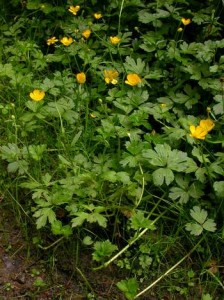by Cynthia Lee Riskin
Master of Environmental Horticulture
According to folklore, if you hold a buttercup against your neck under a full moon, you’ll lose your sanity. If that doesn’t send you over the edge, just watching “crazyweed” take over your yard might do the trick. With the ground sodden with this week’s rains, however, we have a chance to regain some mental health.
Of the dozen or so buttercup species in our area, only creeping buttercup (Ranunculus repens) and tall buttercup (Ranunculus acris) are nonnative, from Europe. Both have hairy, jagged leaves and disarmingly cute yellow flowers. Creeping buttercup usually spreads along the ground, although it can reach 2 feet if not mowed—whereas tall buttercup grows erect to 3 feet. Both evergreens spread by vigorous root systems and produce copious seeds, which can sprout up to 20 or even 80 years after they’re deposited.  Creeping buttercups outnumber all the rest of the buttercups together.
Creeping buttercups outnumber all the rest of the buttercups together.
All buttercups are toxic, containing protoanemonin, which can irritate skin and mucosa, causing itching, blistering, and rashes. Tall buttercup is more poisonous than the creeping species. In humans and other animals—such as goats, pigs, poultry, dogs, cats, rabbits, and guinea pigs—symptoms of buttercup poisoning include drooling, vomiting, bloody diarrhea, and, rarely, kidney damage or seizures. Because protoanemonin is irritating and bitter, however, most creatures avoid eating them.
King County recommends preventing their spread into uninfested and natural areas. Homeowners and renters might want to get rid of them in any case. Their presence generally indicates poorly drained, acidic, wet, and/or compacted soils with low fertility. Improving drainage, fertilizing, aerating, and then overseeding with turfgrasses, planting dense groundcovers, or mulching heavily can help. Applying lime to make soils less acidic can discourage new infestations but won’t get rid of established plants. Neither will mowing, although mowing to the correct height for your grass type and cleaning seeds off your lawnmower before moving to a new spot can stymie spreading.
When the soil is wet or the infestation large, however, the shovel is the best tool for the job. Saturated soils more-easily release the tenacious roots. Digging when the soil is dry merely breaks up the roots and stems, generating new plants.
For more information, see the King County Noxious Weed Control Program Weed Alert: Creeping Buttercup (Ranunculus repens). http://your.kingcounty.gov/dnrp/library/water-and-land/weeds/Brochures/Creeping_Buttercup_FactSheet.pdf.
For approximate pronunciations, click the audio files.
Photo by Ben Legler (C)2004.
Selected Sources
- Ace, D. L., L. J. Hutchinson, and G. F. W. Haenlein. No date. Poisonous Plants, Extension Goat Handbook. Contributed by National Agricultural Library. http://netvet.wustl.edu/species/goats/goatpois.txt.
- Health Grades Inc. ©2014. Symptoms of buttercup poisoning. In: Right Diagnosis from Healthgrades. http://www.rightdiagnosis.com/b/buttercup_poisoning/symptoms.htm.
- Jacobs, J., M. Graves, and J. Mangold. 2010. Plant guide for tall buttercup (Ranunculus acris L.) USDA-Natural Resources Conservation Service, Montana State Office. Bozeman, Montana. http://plants.usda.gov/plantguide/pdf/pg_raac3.pdf.
- Jacobson, A.L. 2008. Wild plants of greater Seattle, 2nd edition. Seattle, WA: Arthur Lee Jacobson. Print.
- King County Noxious Weed Control Program Weed Alert. No date. Creeping buttercup (Ranunculus repens) http://your.kingcounty.gov/dnrp/library/water-and-land/weeds/Brochures/Creeping_Buttercup_FactSheet.pdf
- Pet Poison Helpline. ©2014. Buttercup. http://www.petpoisonhelpline.com/poison/buttercup/.
- [USDA] United States Department of Agriculture ([Date unknown]) Conservation plant characteristics: Ranunculus repens L. [NRCS] Natural Resources Conservation Service, Plants Database. http://plants.usda.gov/java/charProfile?symbol=RARE3.
(C)2014 Cynthia Lee Riskin, all rights reserved in all formats everywhere.


This is great! Thanks for the info via this site – I have been working on these for years and am making some headway in one area. Now I know to make even more of an effort in the section of yard where we spend more time and my dog runs. Thanks!
Good info!